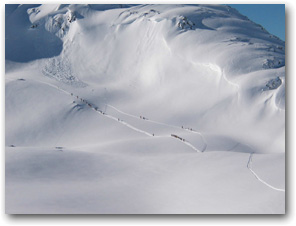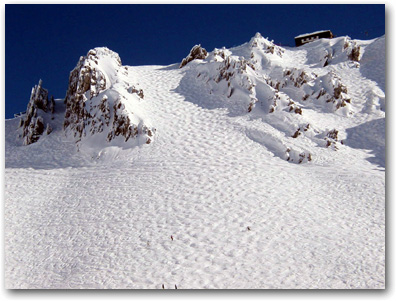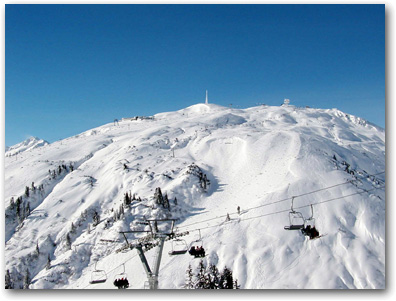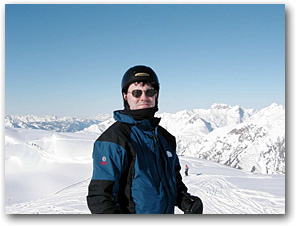
|
|
|

|
|
|
We spread out in a large first-class compartment and slept most of the two and half hour trip to St. Anton. Every so often, I would wake up and peer out our large window. The snow kept getting deeper and deeper. By the time we reached the Austria border near Bregenz, the snow along the side of the tracks was over 2 meters in height. Langen am Arlberg, the stop for Lech, looked like a scene from the Trans Siberian railroad: a station attendant struggled to clear a small path from the platform to the train, but the snow was clearly winning. No one exited the train at Langen and only a handful of skiers got off at the next stop, St. Anton.
The St. Anton train station, recipient of numerous architectural awards for its bold, modern style, is less than 50 meters from the village pedestrian zone and the lifts. For that reason, it is a very popular resort for skiers who prefer train to car travel. In Europe, everything connected with cars is expensive and often inconvenient: gas, parking, tolls, insurance, highway stickers, taxes, and rental fees. Train travel, by comparison, is more affordable, very efficient, and comfortable. Rather than fighting snow covered mountain roads in a rental car, a weary transatlantic traveler can relax with a glass of his favorite beverage and enjoy splendid mountain views from the safety of a large train seat or spread out in the dining car while enjoying a hot lunch.
In a snow storm, St. Anton lives up to its reputation as a fairytale Tyrolean village. Our hotel was just up the street from the Kirchplatz, a square featured in nearly every postcard of the area, and just meters away from the pedestrian zone with its shops, world-class restaurants, cafes, and nightclubs. About the nightlife, one reviewer on www.goski.com wrote that the “the energy of the nightlife in St. Anton is not in the same league as any other ski resort, and is only comparable to the nightlife in New York city.” Many come to St. Anton simply for the après ski. For us, however, skiing is the main attraction and we rarely stay up past ten; however, we’re always up for first tracks early in the morning.
After a splendid meal of salad and goulash at Amalis Cafe, my favorite café in town, we collapsed under goose down comforters covered with 300 thread count duvet covers. “This is like sleeping in cloud,” Darina remarked shortly before losing consciousness. We awoke the next day to the sound of avalanche blasting. It was a bluebird day, but most of the upper slopes of St. Anton were still closed due to unstable snow. Along with hundreds of other powder hungry skiers, we made our way up to Nasserein gondola, a two-year old high-speed, 8 person gondola that whisks skiers up 572 vertical meters (nearly 2,000 vertical feet) in just five minutes. By the time we hit the Gampen terminal, we noticed that the high-speed chairs heading up to Galzig were now running, so we crossed over to the other side of St. Anton to try and get higher up the mountain.
St. Anton is a huge area: about the size of two Vails. Like Whistler, the mountain offers different skiing experiences at different altitudes. The 1800 meter (5,905 foot) level of St. Anton (Galzig and Gampen mid stations) contains some of the best intermediate terrain. Valluga Grat and Schindler peaks (2650 meters/8,694 feet), just above Galzig, contain more advanced terrain and also access to an enormous number of backcountry descents. For the brave, Valluga (2810 meters/9,219 feet) offers even more backcountry options, including a run down to Zürs, but be forewarned: the top of Valluga is so steep that a fall can occasionally result in death. Some of the trails leading down to the village from Gampen and Galzig are also quite steep but there is generally an easy route down - especially when the snow is good.
Under less than ideal conditions, timid or just plain tired intermediates can download on the Nasserein gondola or Galzig tram rather than fight the occasionally icy and crowded lower slopes. If that weren’t enough, St. Anton has three additional base areas: Rendl, St. Christoph, and Stuben. Each of these areas is the size of a mid-sized U.S. resort and allows access to even more backcountry. Rendl, with its west facing runs, is a favorite local’s spot to catch afternoon sun, and enjoy the outside tea dances in ski boots at the “Rendl Beach” restaurant. Rendl also features a fabulous 1100 meter (3600 feet) vertical run from Gampberg down to the gondola station, where you’ll experience everything from steep bowl skiing to narrow tree-lined steeps all in a single run.
The editors of Where to Ski and Snowboard Worldwide claim that St. Anton “vies with Val-d’Isère for the title of resort with the most undergraded slopes.” Many of the red (intermediate) and even some blue (easy) trails would be black (expert) at other European resorts. By Mid-Atlantic standards, some of the blue trails might rate double black. One should be very comfortable skiing grades as steep as Lower Shay’s at Snowshoe before coming to St. Anton. Beginners and timid intermediates might wish avoid the resort altogether. Darina and I consider ourselves to be expert skiers by Mid-Atlantic standards and advanced intermediates by Vermont standards. Both of us are comfortable on 90 percent of the marked pistes at St. Anton. However, St. Anton could be more accommodating to intermediates by indicating on its trail maps what the easiest descents are from each major station.
|
The Kandahar Legend Each year, one of the most difficult downhill races in the world (Kitzbühel and Wengen are the others) is held in St. Anton. The “Kandahar” race consists of a downhill and a slalom event. The name “Kandahar” comes from the town in Afghanistan and the scene of recent fighting during last year’s war in Afghanistan. In 1879, an English officer, Frederick Roberts, rescued the besieged garrison of British troops in Kandahar. He was subsequently knighted with the title “Earl of Kandahar.” In 1911, Roberts, who was an avid skier donated a cup to be awarded to the winner of the Kandahar race. Since then, the event has been known as the “Arlberg-Kandahar” race. |
We began our day taking some runs down the number 5 “Osthang” trail at Galzig. This huge snowfield covers 481 meters (1578 feet) of vertical and is served by a new, high speed detachable quad. One of the highlights of the run was stopping to watch a police helicopter bomb Schindler peak with dynamite sticks. The explosions set off small avalanches that rolled all the way to the closed Steissbachtal valley trail. Unlike in the U.S. where the National Ski Patrol does much of the avalanche protection around ski resorts, in Austria this function as well as back country search and rescue are performed by the “Gendarmerie,” the Interior Ministry’s elite national police force.
Around noontime, we decided to head back to St. Anton to inquire about the road to Lech. Unfortunately, the only open trail from Galzig to St. Anton was the number 2 Kandahar trail, one of the steepest marked trails on the mountain and the site of the world famous Kandahar downhill course. Skier traffic and new snow had bumped the trail up by the time we got on it at noon. Nevertheless, Darina and I made it down with no major problems or falls. We then cruised down the blue Zammermoos back to town, stopping about 400 meters from the bottom to enjoy a nice Wiener schnitzel at one of the many slopeside huts that line the bottom fifth of the trail.

|
|
|
Lech will be covered in a separate article, but before I leave St. Anton, allow me to fast forward to Wednesday, when we returned to the area to cover some of the terrain we missed on our first day. Both Lech and St. Anton share the same lift pass: a chip card that automatically opens turnstiles leading to lifts. The two areas are linked by an efficient and free shuttle bus system. From Lech, the easiest access to St. Anton is the Rauz mid-station. From Rauz, you can either ski down to Stuben and sample the slopes of Albona or take the Valfagehrbahn triple up 617 vertical meters (2024 feet) to Ulmerhütte. Today, we opted to ski the high, southeast facing Albonagrat slopes in the morning and then head up to Ulmerhütte in the afternoon.
I had never skied the highest sections of Albona before, but Dirk Messing, one of our waiters at the Felsenhof hotel in Lech and an extreme snowboarder, recommended it highly. “It’s the last area to open after heavy snow, and one of the best powder areas in the Arlberg,” he told us. We were not disappointed. You ride three chairlifts to get from Stuben (1400 meters/4,593 feet) to Albonagrat (2400 meters/7,874 feet). This is the “end of the world” as far as St. Anton is concerned and is rarely crowded despite its pristine snowfields, steep groomers, and panoramic views of the Alps. Fearing avalanches, we stuck to the protected marked pistes and routes. However, we marveled at the free riders venturing off-piste for descents all the way down to Langen (about 8,000 vertical feet below us). St. Anton vies only with Chamonix as the epicenter of European off piste skiing. At the local bookstore, one can purchase a thick guidebook listing hundreds of off-piste routes. Before attempting these runs, though, I recommend hiring a certified mountain guide and renting basic avalanche equipment such as a shovel, probe, and beacon.
During the afternoon, we descended down to Stuben along the number 3 Seelehang trail, a steep red with a huge double fall line in one section. From Seelehang, we took the blue 1 trail down to Rauz, and from there, the Valfagehrbahn to Ulmerhütte. While on the lift, Darina noticed no lines at the Schindler chair despite the fact that Wednesday was a bluebird day with good temperatures (-10 Centigrade/14 Fahrenheit), and perfect visibility. “I think we’ll put Schindler on our list,” I told her as we disembarked from Valfagehrbahn. The Schindler lift stands out as one of the 8 wonders of the ski world. It climbs the impossibly steep southern slope of the peak over jagged rocks. Every time I ride that lift, I wonder how it has survived Schindler’s many avalanches and rockslides. I also wonder how I will get down. Last year, the run down the north slope was a steep, icy, bumpy, narrow, crowded, black-a grit your teeth and go trail. This year, the trail was widened a bit and reclassified as red. With good snow, it was a snap. Better skiers than myself were cutting off the trail early and heading down the epic off-piste Western mogul run.
We ended our day at St. Anton by skiing one of my favorite cruising runs in the Arlberg: the Valfagehr valley run from Ulmerhütte to Rauz. This is a wide blue trail that runs through a high alpine valley and then drops down a reasonably steep, often bumped up, wall just above Rauz.

|
|
|
That being said, this resort is not a quiet place. It boasts a nightlife that rivals Adams Morgan, and is a meeting place for some of the greatest skiers on the planet. Austria’s national ski team trains on the slopes of St. Christoph, and the Warren Miller film crew makes regular appearances here to film free riders going airborne off the back of Albona, Valluga, or one of the many other peaks in the Arlberg. In short, this is high testosterone place, but ironically, also a place where a couple of confident intermediates like Darina and myself can feel at home on the slopes and be inspired by greatness.
Photos by John Sherwood.
John Sherwood is a columnist for DCSki. When he's not hiking, biking, or skiing, he works as an author of books on military history.